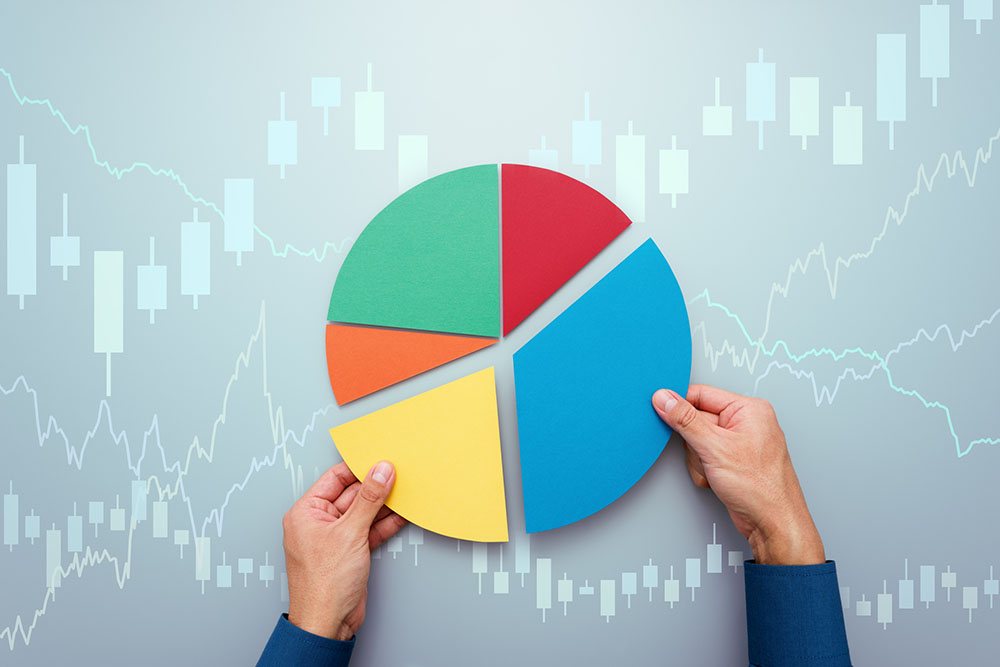Market Update – February 2024
Global markets have continued to rally this month, with strong returns seen in the US and Europe in particular. Markets are still dominated by a small number of companies – the Magnificent Seven in the US, and their smaller European counterparts, the Granolas.
The UK has fared less well and continues to lag behind most developed economies on a rolling basis.
Have Bond Markets Returned to Normal?
Conventional investing wisdom tells us that bonds are a diversifier for equities. Not only do they tend to be more stable during volatile periods, but they often move in opposite directions depending on what is happening in the market. This led to the popularity of the 60:40 portfolio, which allowed investors to benefit from equity gains while offsetting the volatility with bonds.
This has turned on its head in recent years, with bonds and equities often moving in the same direction. In 2022, many bond funds experienced losses on par with equity funds, and were slower to recover.
However, with inflation now returning to more normal levels and interest rates stabilising, it appears that the two asset classes are starting to reach equilibrium again.
In 2024 so far, developed market stocks have gained 3.8%, while global bonds have dipped by 2.8%. This suggests a return to negative correlation, which many analysts believe will continue.
What’s Next for the Magnificent Seven?
The Magnificent Seven, and previous iterations such as FANG (Facebook, Amazon, Netflix, and Google), and MAMAA (Meta, Amazon, Microsoft, Apple, and Alphabet), have dominated US (and by extension, global) markets for some time now.
If you own investments of any kind, it is highly likely that you have some exposure to these companies, whether this is through direct stocks, a diversified portfolio, an index tracker, or indirectly through your pension fund.
The companies make up a significant proportion of the US market and the returns they have produced make up a large proportion of the growth in indices such as the S&P 500.
Some concerns have been raised over this, particularly around the narrowing of the investment market and a move away from diversification. This is even more important given the tech-focus of the largest companies – market factors which affect one of the companies are likely to impact all of them.
Investors may also be mindful of the ‘bubble’ effect which impacted tech stocks in the early 2000s. Shares became overvalued to the point that the market crashed. However, we are not in the same position today, as monetary policy has tightened significantly, and start-ups do not have the same access to an easy money supply. Additionally, today’s tech companies have proved their worth in terms of earnings and free cash flow.
The companies that survived and thrived following the crash are now mature global players returning healthy profits. However, while a bubble situation is unlikely, investors should be wary of concentration risk and paying too much for overvalued shares.
Why Should Investors Care About Granolas?
The factors which have led to the market dominance of the Magnificent Seven can also be seen elsewhere.
In Europe, we have the Granolas (or more accurately, GRANNLLASS), a more elegant acronym which refers to some of the largest companies in the region:
- GSK
- Roche
- ASML
- Nestle and Novartis
- Novo Nordisk
- L’oreal
- LVMH
- AstraZeneca
- SAP
- Sanofi
These companies have accounted for 50% of the gains on the Stoxx 600 index, and have been the subject of half of all mergers during the last five years. Their contribution to the index is expected to grow over the coming years.
The companies have collectively returned around 18% over the last year, which is broadly in line with the Magnificent Seven.
The Granolas are cheaper than the Magnificent Seven, with shares trading at 20 times earnings forecasts compared with their American counterparts’ 30 times earnings. However, they are still considerably smaller than the US collective, with a total market cap of $3 trillion versus $13 trillion.
Over time, it is not unusual for indices to tilt towards larger companies. As they grow in size, they attract more investment, as well as making up a higher proportion of passive funds. This leads to a snowball effect where big companies keep getting bigger. The main risk to investors is concentration – if investment funds are favouring the same few companies, there is more exposure should anything go wrong.
However, unlike their tech-heavy US counterparts, the Granolas are spread across several industries, including pharmaceuticals, food products, and luxury goods. This is good news for diversification.
The UK Market
The UK market has produced modest growth this month, with returns of 0.2% produced by the All Companies sector and 1% by the FTSE 100. This suggests that larger companies are faring slightly better than the wider economy. The UK continues to lag behind Europe and the US over 1, 3, and 5 years. Inflation remains above target at 4.2%.
The impact of Covid, Brexit, and the energy crisis have contributed to this, but economists have suggested that the real issues go back to the 1990s, when investment in the public and private sector started to decline.
The top performer this month, by some margin, is clothing retailer Superdry. While the company has been struggling, the share price has been boosted by discussions of a possible takeover. Currys and Auction Technology Group have also seen strong returns after a difficult few years.
The Global Outlook
The North American sector continues to produce strong returns, with growth of 4.4% over the last month. The S&P 500 reached a record high earlier this month following Nvidia’s earnings announcement – the company grew in value by almost $277 billion, the largest one-day boost in market history. The broader market, led by tech stocks, followed suit.
Europe also had a positive month, with the sector returning around 3.6% for the month. While the results have been positive, led by the ‘Granolas’ mentioned above, Europe does not have a strong financial sector like the US, which is likely to hinder longer-term growth.
The Asia Pacific region has produced returns of 4% this month, following a few turbulent years. Chinese stocks have been boosted due to strong spending following the new year.
Please don’t hesitate to contact a member of the team for more information on any of the topics covered.












